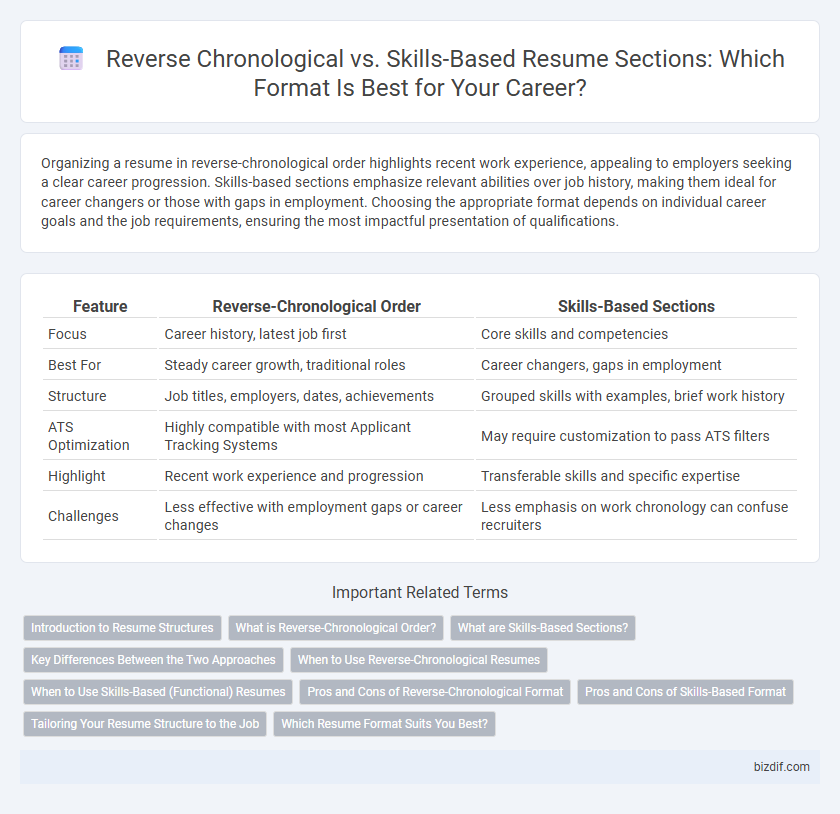Organizing a resume in reverse-chronological order highlights recent work experience, appealing to employers seeking a clear career progression. Skills-based sections emphasize relevant abilities over job history, making them ideal for career changers or those with gaps in employment. Choosing the appropriate format depends on individual career goals and the job requirements, ensuring the most impactful presentation of qualifications.
Table of Comparison
| Feature | Reverse-Chronological Order | Skills-Based Sections |
|---|---|---|
| Focus | Career history, latest job first | Core skills and competencies |
| Best For | Steady career growth, traditional roles | Career changers, gaps in employment |
| Structure | Job titles, employers, dates, achievements | Grouped skills with examples, brief work history |
| ATS Optimization | Highly compatible with most Applicant Tracking Systems | May require customization to pass ATS filters |
| Highlight | Recent work experience and progression | Transferable skills and specific expertise |
| Challenges | Less effective with employment gaps or career changes | Less emphasis on work chronology can confuse recruiters |
Introduction to Resume Structures
Reverse-chronological order emphasizes listing work experience from the most recent to the oldest, highlighting career progression and stable employment history. Skills-based sections prioritize relevant competencies and achievements over job titles or dates, appealing to employers seeking specific expertise. Choosing the appropriate resume structure depends on career goals, job relevance, and the need to showcase either experience or skill sets effectively.
What is Reverse-Chronological Order?
Reverse-chronological order in resume writing highlights professional experience by listing jobs starting with the most recent position and moving backward in time. This format emphasizes career progression and work history, making it easier for employers to assess relevant experience and job stability. Commonly preferred by recruiters, reverse-chronological resumes showcase a clear timeline, enabling quick evaluation of skills and achievements within each role.
What are Skills-Based Sections?
Skills-based sections highlight specific competencies and abilities relevant to the job, organizing information by skill rather than by date. This format allows candidates to emphasize their qualifications, such as technical proficiencies, leadership capabilities, or communication skills, especially when lacking extensive work history. Employers quickly identify core strengths and relevant expertise through a clear, targeted presentation of skills.
Key Differences Between the Two Approaches
Reverse-chronological resumes emphasize work experience in order of most recent to oldest, showcasing a clear career progression and stability to potential employers. Skills-based sections highlight relevant competencies and achievements, making them ideal for career changers or those with employment gaps. Choosing between the two depends on whether you want to emphasize a consistent work history or specific skill sets tailored to the job.
When to Use Reverse-Chronological Resumes
Reverse-chronological resumes are ideal for professionals with a consistent work history in the same industry, showcasing career progression and stability by listing jobs from the most recent to oldest. This format emphasizes job titles, companies, and dates, making it easier for hiring managers to track experience and qualifications. Candidates seeking roles aligned with their previous positions benefit most from this approach, as it highlights relevant accomplishments in a clear, time-based framework.
When to Use Skills-Based (Functional) Resumes
Skills-based (functional) resumes are ideal for job seekers with gaps in employment, diverse career paths, or those transitioning to a new industry, as they highlight relevant abilities over chronological work history. This format emphasizes core competencies and achievements, making it easier for employers to identify transferable skills. Use skills-based resumes when your career narrative benefits more from demonstrated capabilities than a linear job timeline.
Pros and Cons of Reverse-Chronological Format
The reverse-chronological format highlights recent professional experience, making it ideal for candidates with a strong, continuous work history and clear career progression. It allows recruiters to quickly assess job titles, companies, and dates, enhancing credibility and relevance in traditional industries. However, this format may disadvantage those with employment gaps, frequent job changes, or insufficient direct experience, as it emphasizes timeline over transferable skills.
Pros and Cons of Skills-Based Format
Skills-based resume formats highlight relevant competencies and accomplishments, making them ideal for career changers or individuals with employment gaps by emphasizing transferable skills over job chronology. This format can help recruiters quickly identify essential qualifications but may obscure the timeline of work experience, potentially raising concerns about consistency or career progression. Its effectiveness depends on tailoring sections to clearly demonstrate how skills apply to the desired role while maintaining clarity and coherence.
Tailoring Your Resume Structure to the Job
Tailoring your resume structure to the job involves choosing between reverse-chronological order and skills-based sections depending on your experience and the job requirements. Reverse-chronological resumes highlight recent work history, ideal for candidates with a clear career progression, while skills-based resumes emphasize relevant abilities, benefiting those with gaps or career changes. Aligning your resume format with the job description increases the chances of passing applicant tracking systems and catching recruiters' attention.
Which Resume Format Suits You Best?
Choosing the right resume format depends on your work history and career goals, with the reverse-chronological order highlighting recent job experiences and skills-based sections emphasizing core competencies. Reverse-chronological resumes suit candidates with a strong, continuous employment record looking to showcase career progression, while skills-based resumes benefit those with gaps in employment or career changers by focusing on transferable skills. Assessing your professional background and the job description ensures selecting a format that effectively demonstrates your qualifications to hiring managers.
Reverse-Chronological Order vs Skills-Based Sections Infographic

 bizdif.com
bizdif.com